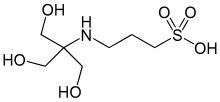TAPS (buffer)
 | |
| Names | |
|---|---|
| IUPAC name
3-{[1,3-dihydroxy-2-(hydroxymethyl)propan-2-yl]amino}propane-1-sulfonic acid | |
| Other names
N-Tris(hydroxymethyl)methyl-3-aminopropanesulfonic acid | |
| Identifiers | |
3D model (JSmol) |
|
| ChemSpider | |
| ECHA InfoCard | 100.045.398 |
PubChem CID |
|
| |
| |
| Properties | |
| C7H17NO6S | |
| Molar mass | 243.27 g·mol−1 |
Except where otherwise noted, data are given for materials in their standard state (at 25 °C [77 °F], 100 kPa). | |
| Infobox references | |
TAPS ([tris(hydroxymethyl)methylamino]propanesulfonic acid) is a chemical compound commonly used to make buffer solutions.
It can bind divalent cations, including Co(II) and Ni(II).[1]
TAPS is effective to make buffer solutions in the pH range 7.7–9.1, since it has a pKa value of 8.44 (ionic strength I=0, 25 °C).[2]
The pH (and pKa at I≠0) of the buffer solution changes with concentration and temperature, and this effect may be predicted e.g. using online calculators.[3]
References
- ↑ Machado, C. M. M.; Gameiro, P.; Soares, H. M. V. M. (2008). "Complexation of M–(buffer)x–(OH)y systems involving divalent ions (cobalt or nickel) and zwitterionic biological buffers (AMPSO, DIPSO, TAPS and TAPSO) in aqueous solution". J. Solution Chem. 37 (5): 603–617. doi:10.1007/s10953-008-9265-3.
- ↑ Goldberg, R.; Kishore, N.; Lennen, R. (2002). "Thermodynamic quantities for the ionization reactions of buffers" (PDF). J. Phys. Chem. Ref. Data. 31: 231–370. doi:10.1063/1.1416902.
- ↑ "Biological buffers". REACH Devices.
This article is issued from
Wikipedia.
The text is licensed under Creative Commons - Attribution - Sharealike.
Additional terms may apply for the media files.